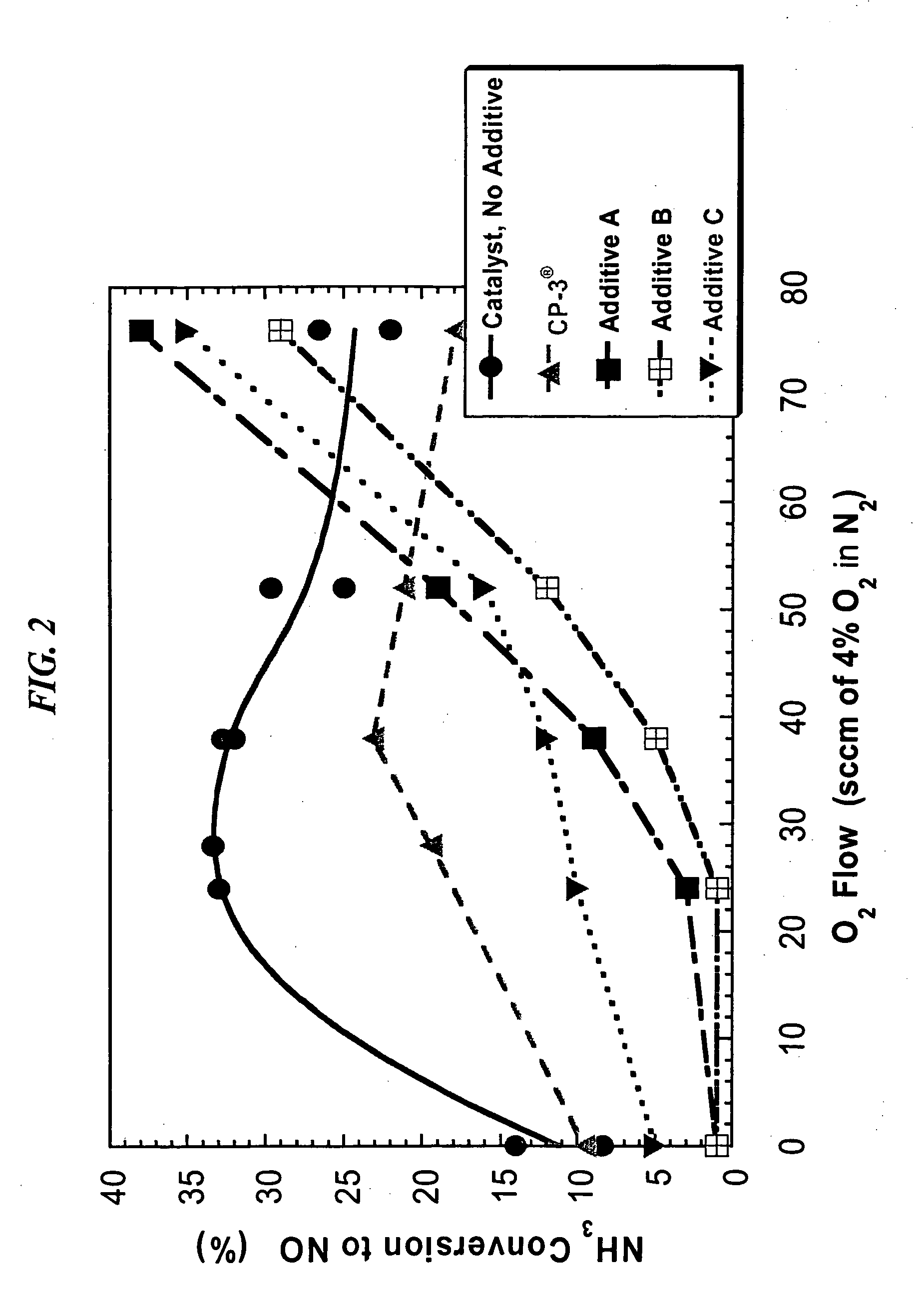Reduction of gas phase reduced nitrogen species in partial burn FCC processes
a technology of partial burn and nitrogen species, which is applied in the field of process for the reduction of nox emissions in refinery processes, can solve the problems of reducing the efficiency of fcc process, and reducing the overall nox emissions. , the effect of reducing the overall nox emissions
- Summary
- Abstract
- Description
- Claims
- Application Information
AI Technical Summary
Benefits of technology
Problems solved by technology
Method used
Image
Examples
example 1
[0085] A microspheriodal particulate support material having the following analysis: 2.3% total volatiles, and approximately 4.5% SiO2, 5% Na2O, 16.8% CeO2, and 73% Al2O3, and BET surface area of 140 m2 / g was prepared as a base material for the preparation of a NOx composition of the invention. A slurry was prepared from an aqueous alumina slurry having 20% solids of a peptizable alumina (Versal 700 alumina powder, obtained from La Roche Industries Inc., 99% Al2O3, 30% moisture). The alumina slurry was prepared using 31.6 lbs of the alumina powder. To the alumina slurry 3.87 lbs of an aqueous sodium hydroxide solution (50% NaOH) was added. Next, 10.4 lbs of cerium carbonate crystals (obtained from Rhone Poulenc, Inc., 96% CeO2, 4% La2O3, 50% moisture) was added to the slurry. The slurry was diluted with a sufficient amount of water to bring the solids concentration of the slurry to 12%. Finally, 3.38 lbs of ion exchanged silica sol of Nalco 1140 (obtained from Nalco Chemicals Co.) w...
example 2
[0086] An Additive A was prepared using the base material prepared in Example 1. 80 g of the base material was placed in an inclined beaker on a mechanical rotator. A platinum impregnation solution was prepared by weighing out 0.1715 g of a platinum tetramine dihydroxide aqueous solution containing 22.79% platinum and diluting with DI water to 100 g total. The base material was then impregnated by gradually spraying with 50 g of the dilute Pt solution through an air mist spray nozzle system. The wet impregnated base material was dried in an oven at 120° C. over night. The dried cake was in the form of large chunks and was first ground in a blender and screened before calcining at 650° C. for two hours to decompose the nitrates and remove volatiles. The resulting material contained: 72.5% Al2O3, 4.4% SiO2, 5% Na2O, 18.8% CeO2, 331 ppm Pt, and had a BET surface area of 135 m2 / g and a mean particle size of 58 μm.
example 3
[0087] An Additive B was prepared as described in Example 2 with the exception that the platinum impregnation solution prepared was diluted with DI water to 50 g total and the base material was then impregnated by gradually spraying with all of the latter dilute Pt solution through an air mist spray nozzle system. The resulting material contained: 72.8% Al2O3, 4.4% SiO2, 5.1% Na2O, 17% CeO2, 688 ppm Pt, and had a BET surface area of 141 m2 / g and a mean particle size of 58 μm.
PUM
| Property | Measurement | Unit |
|---|---|---|
| mean particle size | aaaaa | aaaaa |
| mean particle size | aaaaa | aaaaa |
| particle size | aaaaa | aaaaa |
Abstract
Description
Claims
Application Information
 Login to View More
Login to View More - R&D
- Intellectual Property
- Life Sciences
- Materials
- Tech Scout
- Unparalleled Data Quality
- Higher Quality Content
- 60% Fewer Hallucinations
Browse by: Latest US Patents, China's latest patents, Technical Efficacy Thesaurus, Application Domain, Technology Topic, Popular Technical Reports.
© 2025 PatSnap. All rights reserved.Legal|Privacy policy|Modern Slavery Act Transparency Statement|Sitemap|About US| Contact US: help@patsnap.com



